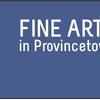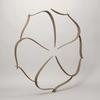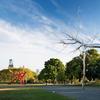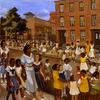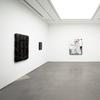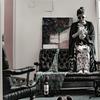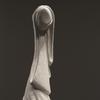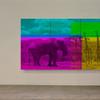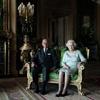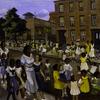Largest Retrospective to Date of the Work of Kerry James Marshall—Opens October 25 at The Met Breuer
- NEW YORK, New York
- /
- September 27, 2016
The largest museum retrospective to date of the work of American artist Kerry James Marshall (born 1955) will open this October at The Met Breuer as a cornerstone of its inaugural season. Encompassing nearly 80 works—including 72 paintings—that span the artist's remarkable 35-year career, this major monographic exhibition reveals Marshall's practice to be a complex and compelling one that synthesizes a wide range of pictorial traditions to counter stereotypical representations of black people in society and reassert the place of the black figure within the canon of Western painting.
Kerry James Marshall: Mastry will be complemented by the concurrent exhibition Kerry James Marshall Selects, curated by the artist. Marshall will draw some 40 works from The Met collection, ranging from the Northern Renaissance to French post-Impressionism, and from African masks to American photography of the 1950s and '60s, underscoring the global and historical nature of the influences that are predominant in his practice.
"It is with enormous pride that we present this examination of Kerry James Marshall's work at The Met Breuer," said Thomas P. Campbell, Director and CEO of The Metropolitan Museum of Art. "With our collection spanning over 5,000 years, The Met is uniquely positioned to highlight Marshall's deep connection to history. Our visitors will be able to experience the many layers of Marshall's groundbreaking artistic vision as they explore the influences that are central to his work."
The exhibition's curator Ian Alteveer added, "Marshall's work illustrates the American experience as unimaginable without black history and culture. Through the tropes of traditional painting—portraiture, landscape, and other narrative modes—he builds a conversation around visibility and invisibility. The result is a stunning body of work that is both intimate and monumental."
The exhibition is organized by The Metropolitan Museum of Art, New York; Museum of Contemporary Art Chicago; and The Museum of Contemporary Art, Los Angeles.
Sheena Wagstaff, Leonard A. Lauder Chairman of The Met's Department of Modern and Contemporary Art, noted, "This comprehensive look at Marshall's work aligns perfectly with our priorities for The Met Breuer where we are committed to expanding our thinking beyond established standards. Marshall's career is based on the central concern of redressing the absence of the black figure in the canon of Western art. Through a deep knowledge of the history of art, he finds his place in it."
Born before the passage of the Civil Rights Act in Birmingham, Alabama, and witness to the Watts rebellion in 1965, Marshall has long been an inspired and imaginative chronicler of the African American experience. He is known for his large-scale narrative history paintings featuring black figures—defiant assertions of blackness in a medium in which African Americans have long been invisible—and his exploration of art history covers a broad temporal swath stretching from the Renaissance to 20th-century American abstraction. Marshall critically examines and reworks the Western canon through its most archetypal forms: the historical tableau, landscape and genre painting, and portraiture. His work also touches upon vernacular forms such as the muralist tradition and the comic book in order to address and correct, in his words, the "vacuum in the image bank" and to make the invisible visible.
The exhibition's title is a play on words referencing Marshall's comics-inspired Rythm Mastrseries, and the works to be included range from the early and iconic—such as A Portrait of the Artist as a Shadow of His Former Self (1980) and Invisible Man (1986)—to his newest revisions of traditional history painting. One of these major, recent works—Untitled (Studio)(2014), a monumental picture depicting an artist's workspace—was recently acquired by The Met. A veritable catalogue of the genres of painting, it combines still life, portraiture, and landscape with trompe l'oeil and abstraction, and includes many references to the Old Masters. The exhibition will also reunite the five paintings of Marshall's Garden Project series—pictures from the mid-1990s that serve to complicate the idea of public housing as bleak or desolate—for the first time in 20 years. Included among these is these is Watts 1963, which depicts the artist and his siblings at play outside Nickerson Gardens, the projects in Watts where the 8-year-old Marshall and his family lived when they first moved to California in 1963. Pages from the Rythm Mastr project, ongoing since 1999, are also featured in the exhibition. These graphic novel panels highlight Marshall's interest in comics as a vehicle for exploring cultural phenomena, embodied by his band of black superheroes and his incorporation of African American vernacular.
The exhibition is accompanied by a comprehensive and fully illustrated catalogue, with essays by the curators and other scholars, alongside new and collected writings by the artist. It is published by the Museum of Contemporary Art Chicago and Skira Rizzoli.
Concurrent Exhibition
For Kerry James Marshall Selects, which will be displayed in an adjacent gallery at The Met Breuer, Marshall worked with Ian Alteveer, co-curator of the retrospective Kerry James Marshall: Mastry, to handpick works from across The Met collection that are at once touchstones for his artistic life and inspirations for his practice—symbols of the grand traditions he has worked to reinvent. Representing a richly textured group of objects that range from the 16th century to the present, the display includes paintings by Jean Auguste Dominique Ingres, Romare Bearden, and Aaron Douglas; drawings by Paolo Veronese and Georges Seurat; photographs by Roy DeCarava and Walker Evans; a Senufo oracle figure; Japanese woodblock prints; and others.
Marshall's work has been presented in solo exhibitions internationally, most recently at the Museum van Hedendaagse Kunst Antwerpen, Belgium, where a major European retrospective debuted in 2013. It then traveled to the Kunsthal Charlottenborg, Denmark; the Antoni Tapies Foundation, Barcelona; and the Museo Nacional Centro de Arte Reina Sofía, Madrid. In 2010, an exhibition focusing on the artist's representations of the transatlantic slave trade was on view at the National Gallery of Art, Washington, D.C. Other important exhibitions of Marshall's work were held at the Secession, Vienna; Vancouver Art Gallery; San Francisco Museum of Modern Art; Wexner Center for the Arts, Columbus, Ohio; Camden Arts Centre, London; and The Renaissance Society at the University of Chicago. His work has also been included in numerous group exhibitions, including All the World's Futures at the Central Pavilion of the 2015 Venice Biennale.
In 2014, Marshall was the recipient of the Wolfgang Hahn Prize, an award given annually by the Gesellschaft für Moderne Kunst at the Museum Ludwig in Cologne. In 2013, he was one of seven new appointees named to President Barack Obama's Committee on the Arts and the Humanities. His other prestigious awards include a 1997 "genius" grant from the MacArthur Foundation and a 1991 fellowship from the National Endowment for the Arts.
The artist's works are held by The Metropolitan Museum of Art, New York; Art Institute of Chicago; Los Angeles County Museum of Art; Museum of Contemporary Art Chicago; Museum of Contemporary Art, Los Angeles; The Museum of Modern Art, New York; National Gallery of Art, Washington, D.C.; San Francisco Museum of Modern Art; The Studio Museum in Harlem, New York; Walker Art Center, Minneapolis; and the Whitney Museum of American Art, New York; among many others.
Marshall was born in Birmingham, Alabama, in 1955 and grew up in Los Angeles. He holds a BFA (1978) and honorary doctorate (1999) from the Otis College of Art and Design. Marshall works in Chicago, where he has lived since the late 1980s.
The exhibition is featured on The Met website

